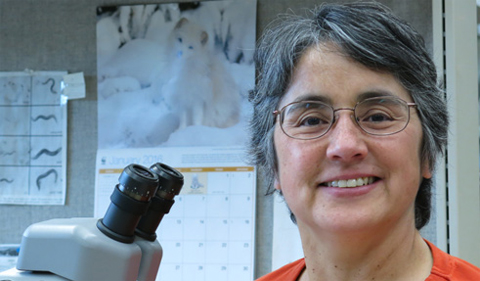Dr. Janet Duerr, Associate Professor of Biological Sciences at Ohio University, is a co-author on a paper titled “Whole-animal connectomes of both Caenorhabditis elegans sexes” in Nature.
Duerr joined researchers from Albert Einstein College of Medicine, Columbia University, and Google in describing and modeling all neural connections in this simple animal.
The New York Times wrote about the study in an article headlined “Stored in Synapses: How Scientists Completed a Map of the Roundworm’s Brain: Redrawing neural connections led to new clues about sex differences in scientists’ favorite model organism.”
The tiny, transparent roundworm known as Caenorhabditis elegans is roughly the size of a comma. Its entire body is made up of just about 1,000 cells. A third are brain cells, or neurons, that govern how the worm wriggles and when it searches for food — or abandons a meal to mate. It is one of the simplest organisms with a nervous system.
The circuitry of C. elegans has made it a common test subject among scientists wanting to understand how the nervous system works in other animals. Now, a team of researchers has completed a map of all the neurons, as well as all 7,000 or so connections between those neurons, in both sexes of the worm.
“It’s a major step toward understanding how neurons interact with each other to give rise to different behaviors,” said Scott Emmons, a developmental biologist at the Albert Einstein College of Medicine in New York who led the research….
According to a news release, “researchers at Albert Einstein College of Medicine describe the first complete wiring diagram of the nervous system of an animal, the roundworm Caenorhabditis elegans, used by scientists worldwide as a model organism. The study includes adults of both sexes and reveals substantial differences between them.”
The findings mark a major milestone in the field of “connectomics,” the effort to map the myriad neural connections in a brain, brain region, or nervous system to find the specific nerve connections responsible for particular behaviors.
…This work was supported by grants from the National Institutes of Health (F31NS096863, R01NS096672, R37NS039996, P30HD071593, R01MH112689, T32GM007491, R01GM066897, and OD 010943), and the G. Harold and Leila Y. Mathers Charitable Foundation.
Abstract in Nature: Knowledge of connectivity in the nervous system is essential to understanding its function. Here we describe connectomes for both adult sexes of the nematode Caenorhabditis elegans, an important model organism for neuroscience research. We present quantitative connectivity matrices that encompass all connections from sensory input to end-organ output across the entire animal, information that is necessary to model behaviour. Serial electron microscopy reconstructions that are based on the analysis of both new and previously published electron micrographs update previous results and include data on the male head. The nervous system differs between sexes at multiple levels. Several sex-shared neurons that function in circuits for sexual behaviour are sexually dimorphic in structure and connectivity. Inputs from sex-specific circuitry to central circuitry reveal points at which sexual and non-sexual pathways converge. In sex-shared central pathways, a substantial number of connections differ in strength between the sexes. Quantitative connectomes that include all connections serve as the basis for understanding how complex, adaptive behavior is generated.




















Comments